 |
Cruciate ligament rupture |
|
 |

 |
The strongest stabilizers of the knee joint are the gluteal muscles which radiate into the tendon on the outside of the thigh and then stabilize the knee during flexing and extension. The abdominal muscles protect the spine and work together with the thigh muscles to relieve the knee joints.
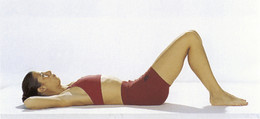 |
Picture 1: Supine position, legs drawn up, spine pressed flat on the supporting surface.
|
 |
Picture 2: Next clench the gluteal muscles and lift the pelvis. Return to the starting position and start the exercise from the beginning (pelvic swing).
This exercise strengthens the gluteal muscles to stabilize the knee joint
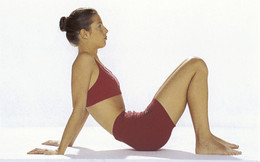 |
| Pictures 3 and 4: The same exercise as before - though somewhat more difficult: Whilst sitting, abdominal muscles tensed, legs drawn up, arms braced on the floor, lift the buttocks by stretching the hips, thighs relaxed, tense the buttocks.
|
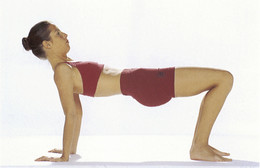
Picture 5: Prone position, left leg bent at the knee. Lift the leg by extending the hip, pelvis remains on the supporting surface. From this one learns how to stabilize the knee with the gluteal muscles.
|
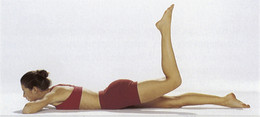 |
|
|
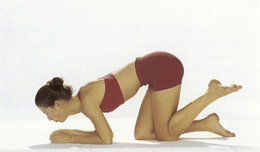
Pictures 6 and 7 : In the knee - elbow position, left leg flexed, calf turned outwards. Lift leg by straightening the hip joint.
We attach particular importance to the interplay = coordination of leg muscles
|
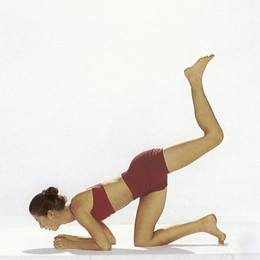 |
|
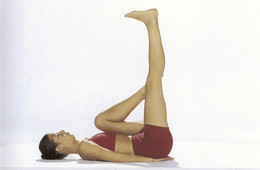 |
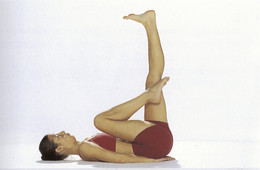 |
|
Pictures 8 and 9: In a supine position, hands under the buttocks, leg movements in opposite directions as a coordination exercise with, successive flexing of the knee, stretching of the ankle, stretching of the knee joint and flexing of the ankle.
|
During these exercises we always ensure that, when the knee is straightened, the ankle joint is flexed and vice versa. In this way we practice and program the principle of walking and running movement.
Strengthening of the leg muscles should never be performed in isolation during the rehabilitation process, but instead in the context of gymnastics and running programs, cycling and jumping exercises. We always begin with stretching exercises to improve the change between loading and relaxation of cartilage, ligaments and tendons.
|
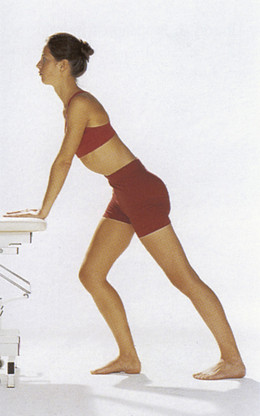
Picture 11: Starting position as for the previous exercise. Turn the left leg inwards to stretch the inside of the left calf; by turning the left leg outside, the outside of the left calf strain is stretched.
.
|
Picture 10: Wide walking stance with the hands braced against a wall, table or chair, left knee joint extended, press heel slowly against the ground. By moving the pelvis forwards, stretching is intensified.
|
|
|
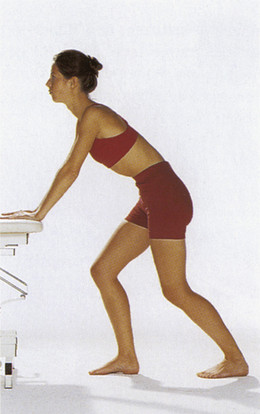 |
Picture 12: Starting position as previous exercise, slow flexing of the left knee joint
|
Picture 13: Stand on one leg, if necessary braced with the left hand on a table or a wall, straightened right arm grasps the back of the right foot. The hip joint is first straightened. The flexing of the knee joint is then intensified by pulling with the hand.
|
|
|
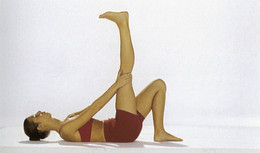 |
Picture 14: In a supine position, left leg flexed; grasp the right leg with both hands (knee joint straightened and ankle joint flexed) and draw it towards the upper body until it reaches an angle of
90 °.
|
Exercising on a wobble board, currently so popular with therapists , does not improve coordination. It does not improve movement patterns, but rather compensatory reflex movements are made which disrupt normal coordination.
Articular cartilage, tendons and ligaments have little or vasculature. During every weight training session a constant changing between pressure and relief must be ensured, and training with elastic bands, expanders and the like should thus be avoided. The interplay between the elasticity of tendons and the application of the muscles represents a key principle of optimal sports performance. Measurements have shown that tendon length can be increased by on average 6% and that up to 90% of the energy absorbed by stretching can be effortlessly re-released. This also explains why marathon running is only possible on hard surfaces: because the Achilles tendons are stretched with each step, only a small amount of additional energy in the form of muscular contraction is required to move forward.
If one tries to take a longer run on a soft surface, like a beach, you will feel this because the tendons will not be stretched and you will have to run using only muscle power. After only a short time one feels stress and strain of joints, tendons and muscles. A marathon run on soft ground would be completely impossible.
Alongside specific exercises for stretching, strengthening and movement, other forms of physical activity, including exercise programs, aerobics, cycling, running and swimming can also contribute to the achievement of full fitness after a cruciate ligament injury. There are athletes who reduce or give up their sport due to illness and injuries. There is however also a large group of people who take up sport only through the rehabilitation following health problems. The joy of movement, the expansion of the physical limits and a balanced diet with specific dietary supplementation only achieve an important meaning for them under these circumstances.
|
|
 |
 |
|
|
|



